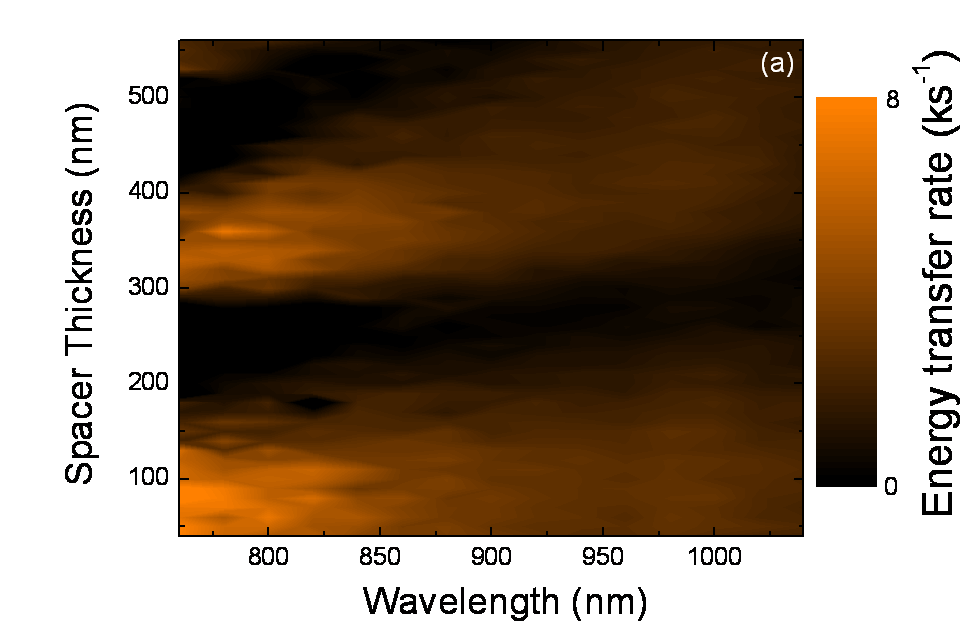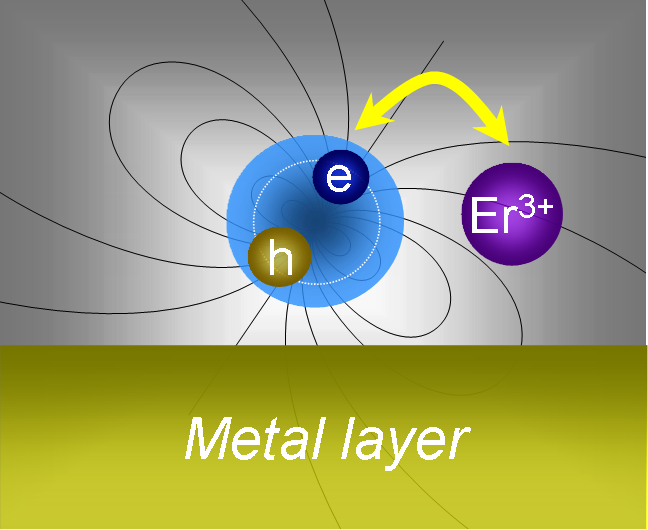|
|
| RESEARCH ACTIVITIES |
 |
| Surface Plamson Enhanced Energy Transfer |
| |
P55. Minoru Fujii, Toshihiro Nakamura, Satoru Miura, Masaki Inui, and Shinji
Hayashi,
“
Energy Transfer from Si Nanocrystals to Er Ions near a Metal Layer,”
Physica Status Solidi (a), Vol. 205, No. 1, pp. 47-51 (2008).
(Published Online: 15 Nov 2007)
(Proceeding of 2nd Workshop on “Impurity Based Electroluminescent
Devices and Materials (IBEDM 2006),” Wakayama, Japan, October 17-20,
2006 (invited talk))
|
| Er ions can be excited efficiently by energy transfer from Si nanocrystals.
There are several different kinds of energy transfer processes depending
on the distance between Si nanocrystals and Er ions. Among them, Förster-type
dipole– dipole interaction is considered to have the longest interaction
distance. In this work, we study how the long-distance inter- action is
modified when Er – Si-nanocrystals coupled system is placed near a metal
layer. We show that the energy transfer rate is strongly modified by the
metal layer and the rate oscillates depending on the distance between the
metal and the coupled system. From the quantitative analysis of the oscillation
behavior, the energy transfer efficiency as well as the rate is estimated
as a function of the energy transfer wave- length, and the evidence of
resonant energy transfer is dem- onstrated. |
|
 |
84. Toshihiro Nakamura, Minoru Fujii, Satoru Miura, Masaki Inui, and Shinji Hayashi,
"Enhancement and Suppression of Energy Transfer from Si Nanocrystals to Er Ions through a Control of the Photonic Mode Density,”
Physical Review B, Vol. 74, pp. 045302-1-6, July (2006). |
| The rate of energy transfer from Si nanocrystals to Er ions was modified
by placing a Au layer nearby. The distance between the active layer and
the Au layer as well as the wavelength were changed systematically to quantitatively
discuss how the energy transfer rate is modified by the photonic mode density.
It was found that at particular combinations of the spacer thickness and
the wavelength the energy transfer was strongly suppressed, while at other
combinations it was enhanced. In order to understand the oscillation behavior
of the energy transfer rate, a model fitting was performed. By assuming
that the energy transfer rate is proportional to the square of the photonic
mode density, the observed oscillation behavior could be well reproduced,
and from the fitting the energy transfer rate could be estimated. The estimated
rates of energy transfer to the 4I11∕2 and 4I9∕2 states of Er3+ were about
31 and 5.7 ks−1, respectively. |
|
 |
78. Toshihiro Nakamura, Minoru Fujii, Kenji Imakita, Shinji Hayashi,
"Modification of Energy Transfer from Si Nanocrystals to Er3+ near Au Thin Film,”
Physical Review B, Vol. 72, pp. 235412-1-6, December (2005). |
| The effects of a Au thin layer on the rate of energy transfer from Si
nanocrystals (Si-nc’s) to Er3+ were studied. The energy transfer rate was
found to oscillate with increasing the separation between the active layer
and the Au thin film. The period of the oscillation agreed well with that
of the calculated radiative decay rates of Si-nc’s at the energy transfer
wavelength. The present results provide evidence that the rate of energy
transfer from Si-nc’s to Er3+ is proportional to the photonic mode density
at the energy transfer wavelength and can be controlled by controlling
the photonic environment. |
|
|
|
| |

|
|
|

